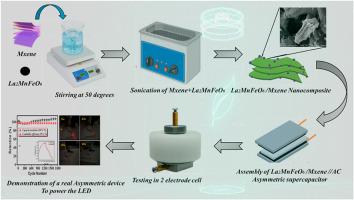La2MnFeO6-double perovskite decorated 2D Ti3C2-Mxene hybrid nanocomposite for superior energy density supercapacitor for efficient LED powering
IF 4.9
3区 材料科学
Q2 CHEMISTRY, MULTIDISCIPLINARY
引用次数: 0
Abstract
The advancement in electrode materials is crucial for the development of high-performance energy storage devices. In this study, we report the synthesis and characterization of a novel nanocomposite consisting of La2MnFeO6 (LMFO) perovskite oxide and 2D Ti3C2 MXene for supercapacitor applications. The LMFO/Ti3C2 nanocomposite leverages the high redox activity of LMFO and the exceptional electrical conductivity and layered structure of Ti3C2, yielding a synergistic effect that enhances electrochemical performance. Comprehensive characterization using X-ray diffraction (XRD), Field Emission Scanning Electron Microscopy (FESEM), Transmission Electron Microscopy (TEM), and X-ray photoelectron spectroscopy (XPS) confirms the successful integration of LMFO and Ti3C2. Electrochemical evaluations in a two-electrode system demonstrate a specific capacitance of 78.0 F g−1 at 0.2 A g−1, an energy density of 67.70 Wh. kg−1, and a power density of 250 W kg−1 over a wide potential window (0–2.5 V). Electrochemical Impedance Spectroscopy (EIS) verifies the low charge transfer resistance of the device. Notably, the incorporation of Ti3C2 enhances the conductivity of the electrode material. This work highlights the potential of LMFO/Ti3C2 nanocomposites as efficient and durable electrode materials, offering a promising avenue for sustainable energy storage systems.

la2mnfeo6 -双钙钛矿修饰二维Ti3C2-Mxene杂化纳米复合材料用于高效LED供电的高能量密度超级电容器
电极材料的进步对高性能储能器件的发展至关重要。在这项研究中,我们报告了一种由La2MnFeO6 (LMFO)钙钛矿氧化物和2D Ti3C2 MXene组成的新型纳米复合材料的合成和表征,用于超级电容器的应用。LMFO/Ti3C2纳米复合材料利用了LMFO的高氧化还原活性和Ti3C2的优异导电性和层状结构,产生了协同效应,提高了电化学性能。通过x射线衍射(XRD)、场发射扫描电镜(FESEM)、透射电镜(TEM)和x射线光电子能谱(XPS)的综合表征证实了LMFO和Ti3C2的成功集成。电化学评价表明,在0.2 a g−1下,双电极系统的比电容为78.0 F g−1,能量密度为67.70 Wh。功率密度250w kg−1,宽电位窗(0 ~ 2.5 V)。电化学阻抗谱(EIS)验证了该器件的低电荷转移电阻。值得注意的是,Ti3C2的掺入提高了电极材料的导电性。这项工作突出了LMFO/Ti3C2纳米复合材料作为高效耐用电极材料的潜力,为可持续储能系统提供了一条有前途的途径。
本文章由计算机程序翻译,如有差异,请以英文原文为准。
求助全文
约1分钟内获得全文
求助全文
来源期刊
CiteScore
7.80
自引率
2.50%
发文量
605
审稿时长
40 days
期刊介绍:
The Journal of Physics and Chemistry of Solids is a well-established international medium for publication of archival research in condensed matter and materials sciences. Areas of interest broadly include experimental and theoretical research on electronic, magnetic, spectroscopic and structural properties as well as the statistical mechanics and thermodynamics of materials. The focus is on gaining physical and chemical insight into the properties and potential applications of condensed matter systems.
Within the broad scope of the journal, beyond regular contributions, the editors have identified submissions in the following areas of physics and chemistry of solids to be of special current interest to the journal:
Low-dimensional systems
Exotic states of quantum electron matter including topological phases
Energy conversion and storage
Interfaces, nanoparticles and catalysts.

 求助内容:
求助内容: 应助结果提醒方式:
应助结果提醒方式:


